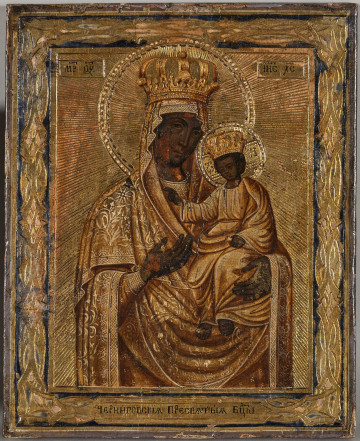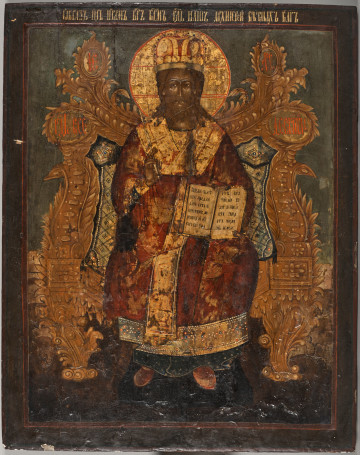
The Mother of God of Hodigitria
19th (?) century
Castle Museum in Łańcut
Part of the collection: Ikony
The story of the prophet Elijah is described in the Books of Kings of the Old Testament and interpreted as a prelude to the coming of the Messiah. Elijah preached the word of Yahweh to King Ahab who, under the influence of his wife Jezebel, introduced idolatrous cults. God sent Elijah to the city of Zarephath, where he stayed with a widow, having brought her dead son back to life. King Ahab held Elijah responsible for Israel’s woes (drought as punishment for the idolatrous cult). Elijah proved the falsity of Baal, offered a burnt offering to Yahweh on Mount Carmel and dispelled doubts about the validity of worshipping the idol, whose prophets were killed. Drought and famine left the land. Nevertheless, the queen swore death to Elijah, who had to hide in the desert. An angel appeared to him there and ravens brought him food. At God’s command, the prophet went to Damascus, anointed Khazael and Jehu as kings, and Elisha as prophet and his successor. Together with Elisha, Elijah was travelling to Bethel and Jericho when they both passed between the parted waters of the Jordan – he left his garment to his disciple and ascended into heaven on a horse-drawn fiery chariot. According to the non-canonical Apocalypse of Elijah, he and Henoch are to oppose the Antichrist in the end times; slain, they are to be resurrected to defeat him. Many Orthodox theologians believe that Elijah will return before the second coming of Christ to die physically and then rise again. The depiction of the history of the prophet with the ascension on the fiery chariot, as in the presented icon, has been established in the Russian Orthodox Church since the 18th century. This iconography was particularly popular with Old Believers in northern Russia, who believe that the true way to heaven leads through fire. The feast of the prophet Elijah is celebrated by Eastern Christians on July 20 (August 2 according to the Julian calendar). Teresa Bagińska-Żurawska https://orcid.org/0000-0002-9243-3967
Dimensions
height: 31 cm, width: 26.5 cm
Object type
Icons
Technique
gilding, tempera
Material
gold, tempera, wood
Origin / acquisition method
decyzja administracyjna
Creation time / dating
Creation / finding place
Owner
Castle Museum in Łańcut
Identification number
Location / status

19th (?) century
Castle Museum in Łańcut

1800 — 1850
Castle Museum in Łańcut

1800 — 1899
Castle Museum in Łańcut
DISCOVER this TOPIC
Museum of King Jan III's Palace at Wilanów
DISCOVER this PATH
Educational path